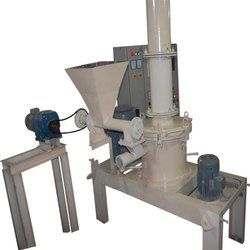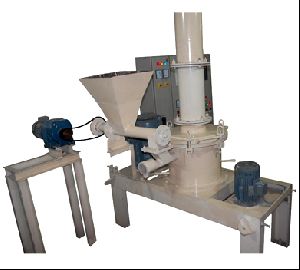
Ultra Fine Air Classifying Mill
Get Price Quote
Salient Features: Grinding and Classifying in one machine Cool and smooth grinding Steep particle size distribution Sharp Classifier cut point, instantly adjustable. Easy cleaning and maintenance. Low specific energy requirement Compact space saving design. Principle Of Operation: The material to be ground is conveyed from a hopper by screw feeder or pneumatically fed through Rotary Air Lock Feeder to the grinding chamber of the Air Classifying Mill (ACM). The pins/bars of the rotor break the particles of the material. These particles are entrained by an air stream which enters below the pin rotor and are carried up between the inner wall and the shroud ring with baffles which decrease the air swirl. These particle then enter the classifying section where the fine material is carried out with the air through the classifier rotor to the outlet, the course material is thrown against the shroud rind and carried down to the pin rotor for further reduction. After leaving the micron air mixed with fine particles enter the bag filter where the fine particles are separated and the clean air is discharged to the atmosphere.

Air Classifying Mill
Get Price Quote
NSI Equipments Pvt. Ltd. Micronizer Systems incorporated a wide range of standard features which can address a wide range of applications. We took steps to assure that our customers are able to source the best mill design for their application. DESCRIPTION Air Classifying Mill (ACM) is a compact micronizer and clear arrangement of element with the combination of air swept impact grinding with integral dynamic classification used for fine and micro-fine size reduction of a wide range of products in all industries like Chemical, Mineral, Pharmaceutical, Food, Metal etc. Rejection of coarse material requiring further size reduction occurs totally inside the chamber by means of a positive material and air transport system. This feature combined with vertically orienting the classifier and impact drive shaft makes the air classifying mill the most efficient type of mechanical mill available. OPERATION The material to be ground is introduced to the tip of the rotating hammers through a port opening at the side of the mill. Feed material can be either pneumatically conveyed or screw fed. The rotating hammers attached to the impact rotor disc serve to fracture the process material with a striking edge velocity up to 140m/s.A serrated liner mounted on the periphery of the grinding chamber in the hammer path serves to improve grinding efficiency by preventing particles from accelerating to the speed of the hammers thereby increasing the relative speed difference. The primary airflow passing through the narrow annular gap formed in between the liner and impact rotor disc in conjunction with the fanning action of the hammers transports the material to the top of the mill. A dispersion ring then directs the material downward toward the classifier. Baffles welded to a shroud ring straighten the flow of material and air so that particle overtaxing at the dispersion ring area is avoided.The shroud assembly effectively separates the grinding zone from the classification as well as providing a defined path for the material and air to flow through.Depending upon the air flow rate and separate speed adjustment, discreet particles are acted upon by either the center seeking drag force of the air that flows through the classifier or center fleeing centrifugal force created by the turning of the classifier wheel. Rejected particles fall by gravity and are pulled under the shroud assembly to the spinning hammers for further impact. SIZE REDUCTION The Mill operates on the principle of IMPECT GRINDING and usually employs rotor speed with a striking velocity of 140 m/s. Size reduction takes place by the impact of material particles on the rotating grinding surface and on the fixed liner. VANE CLASSIFIER The characteristic feature of the ACM is the incorporation of a integral classifier. The classifier works on the principle of two opposite force acting on the different particles, the coarse and the fine particles are segregated. CLEANING & MAINTENANCE ACM is designed in such a way that all the individual components of the mill viz. the shroud ring, the liner plate, the classifier and the rotor plate are easily detachable for cleaning, in case of product change and for maintenance work. The top lid is hinged and tightened with fly nuts. Our air classifying mills incorporate the following features: Units up to 100 HP have standard cast reversible Ni-Hard liners Tungsten carbide hammers. All mills are designed to operate at noise levels below 85 dba* A complete line of sanitary mills is available to meet special cleaning requirements DESIGN FEATURES Grinding and classifying in one machine Steep particle size distribution Sharp classifier cut point, instantly adjustable Low specific energy requirements Compact space saving design Economical, efficient recovery of fine powders Particle size readily adjustable without shutdown Simple to clean, maintain and operate Low grinding temperature Efficient transportation of ground material from grinding rotor to separating element Oversize material rejected back to grinding rotor Precision manufacturing Wide model range for broad application considerations Air Classifying Mill grinding system consists of the following: Feed Hopper Screw/Pneumatic Feeder with Rotary Air Lock Air Classifying Mill Reverse Pulse Jet Bag Filter Discharge Rotary Air Lock ID Fan Inter Connecting Duct Work Control Panel APPLICATION ACM can be used for almost the whole field of size reduction of products upto a hardness of 4 Moh. Due to high air flow rates, the material has less tendency to heat-up and suitable for heat sensitive product size reduction. Our ACM design makes them ideal for the following applications: Food and Food Ingredients Sugars, starches, artificial sweeteners, salt, spices, thickening agents (guar, carrageen, xanthan, gelatin, alginates, and pectin), cocoa press cake, proteins, soy, grains, lactose, peas, fish, corn, rice and shrimp meals, cellulose, confectionery crumb, etc. Nutraceuticals Bovine and shark cartilage, vitamins, magnesium citrate, calcium citrate, ginseng, echinacea, chamomile, oyster shells, psyllium, and oat hulls, etc. Chemicals Stearates, carbonates, sulphates, phosphates, inorganic salts, rubber and plastic additives, resins, carbon black, iron and other metal oxides, compounded powder coatings, silica gel, zeolites, crystalline polymers, herbicides, and pesticides, etc. Functional Fillers and Minerals Limestone, calcined kaolin, hydrous kaolin, calcium oxide, brucite, talc, gypsum, bentonite, wood, walnut shells, calcium hydroxide, soda ash, trona, etc. MATERIAL OF CONSTRUCTION Material of construction of contact parts could be Mild Steel, Stainless Steel etc.
Best Deals from Air Classification Plant